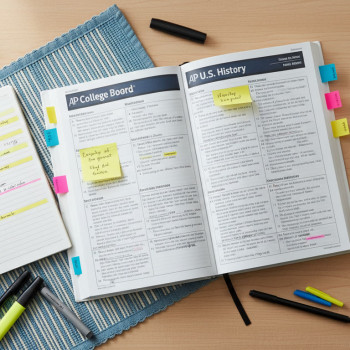What Are Calibration Sessions—and Why Should AP Students Care?
If you’ve ever wondered how the College Board makes sure thousands of free-response answers are graded consistently, the short answer is: calibration. Calibration sessions are the behind-the-scenes workshops where AP readers (the educators who score the free-response sections) review scoring rubrics and compare sample student responses so everyone is aligned. For you as a student, understanding this process removes some mystery from how scores are assigned and gives you concrete ways to write and show your knowledge more clearly on test day.
The goal of calibration in plain English
Calibration is quality control. Think of it as a training meeting where readers learn to apply a scoring guide the same way. The College Board provides exemplars—student responses that represent different score levels—then small groups of readers score independently, compare, and discuss until scoring is consistent across the board. Without calibration, scoring would vary more from reader to reader, and student scores would be less reliable.
How Scoring Samples (Exemplars) Work
Scoring samples, often called exemplars, are annotated student answers that show exactly why a response earned a certain score. Each exemplar is matched to a point on the rubric and includes notes about strengths, weaknesses, and common errors. Readers study these exemplars during calibration so that when they see a real student answer on exam day, they can map it to the closest exemplar and assign the appropriate score.
What an exemplar teaches you as a student
- What level of detail earns full credit
- Which parts of a response graders consider essential versus optional
- How organization, vocabulary, and evidence affect scoring
- Common pitfalls that lower a score
Knowing how exemplars are used lets you focus your practice intentionally: aim to produce the key elements that map to higher-level exemplars.
Three Ways Calibration Improves Fairness—and Your Confidence
Calibration isn’t just bureaucracy. It directly protects you as a test taker and also offers teachable lessons you can use in revision and practice.
- Consistency: The same rubric applied uniformly reduces random differences from reader to reader.
- Reliability: Scores better reflect the student’s performance, not the idiosyncrasies of a single grader.
- Transparency: Exemplars clarify what graders expect; you can mirror those expectations in your answers.
Practical Takeaways: How to Use Calibration Knowledge to Improve Your AP Answers
Let’s translate grader training into student strategy. Below are actionable habits that echo what readers are trained to notice.
1. Answer the question directly and explicitly
Graders first look for whether you addressed the prompt. State your thesis or claim clearly in the opening sentence for essays or state the conclusion succinctly for short-response items. This eliminates ambiguity and makes it easier for a reader to see that you’ve met the task.
2. Organize your response so graders can follow your logic
Use a predictable structure: claim, evidence, explanation. For multi-part questions, label parts (a), (b), (c) in your response so readers don’t have to hunt for each element. Remember: graders score a lot of papers quickly—clarity saves you points.
3. Use exemplar language, not fancy fluff
Readers are trained to reward specific content and reasoning, not flowery prose. If an exemplar emphasizes cause-and-effect chains, use that kind of phrasing—explicit links like “because,” “therefore,” and “as a result”—so your reasoning is visible.
4. Provide targeted evidence
One well-chosen piece of evidence with clear explanation often beats a page of vague statements. When practicing, mimic exemplar responses by choosing evidence that directly supports your claim and explaining the link.
5. Address counterpoints or complexities when relevant
Stronger exemplars often acknowledge nuance. If a prompt invites complexity, briefly note it and explain why your claim still holds—this demonstrates higher-order thinking that graders value.
Study Routine: Practice Like a Calibrated Reader
Train yourself not only to write answers that fit exemplars but to evaluate them. You’ll gain a sharper sense of what earns points.
Weekly practice schedule
| Day | Activity | Time | Purpose |
|---|---|---|---|
| Monday | Review rubric for one question type | 30 min | Understand scoring expectations |
| Tuesday | Write a timed response | 30–45 min | Practice applying rubric under pressure |
| Wednesday | Score your response vs. an exemplar | 30 min | Self-calibration and gap identification |
| Thursday | Rewrite the response incorporating feedback | 30 min | Solidify improvements |
| Friday | Peer review or tutor review session | 30–60 min | Gain outside perspective |
| Weekend | Full practice test section | 2–4 hours | Build stamina and apply skills cohesively |
This routine mirrors calibration itself: learn the standard (rubric), try it (timed response), compare to exemplars, revise, and get an external check. Over time your internal scoring will become more reliable—just like a well-calibrated reader.
Examples: Side-by-Side Comparison of Responses
Seeing how small changes move a response from a lower exemplar to a higher one is the most instructive part of calibration. Below are simplified examples—note the differences in clarity, evidence, and reasoning.
Prompt (example): Explain one major cause of X and support your explanation with evidence.
| Lower-Scoring Response | Higher-Scoring Response |
|---|---|
|
X happened because of many reasons. People were mad and protests started. The government changed policies which led to X. |
X was primarily caused by economic inequality. For example, data from the period show that the top 10% controlled a growing share of income, while wages for the working class stagnated. This disparity fueled protests when unemployment rose by 5% in the immediate aftermath, creating both the motive and the means for widespread unrest. Therefore, unequal distribution of wealth directly contributed to the outbreak of X. |
Compare the two. The higher-scoring response names a precise cause (economic inequality), provides specific supporting evidence, and explains the causal link. That pattern—claim, evidence, explanation—is what exemplars model and what graders reward.
How Teachers and Tutors Use Calibration in the Classroom
Teachers who’ve attended AP professional development or who have experience with AP scoring bring calibration principles into instruction. They often use mini-calibration exercises: students score anonymized responses, defend their ratings, and revise. This active engagement with rubrics deepens understanding far more than passive study.
What a calibration-style classroom activity looks like
- Students read a prompt and multiple anonymous responses
- Each student assigns a score using the rubric and annotates why
- Small groups discuss differences and reconcile scores
- Teacher reveals the exemplar score and leads reflection on gaps
These exercises train you to think like a reader—so you learn to produce the work readers find clear and convincing.
Using Exemplars Ethically: Don’t Copy—Learn
It’s tempting to imitate high-scoring exemplars word-for-word, but that won’t help on test day and could create brittle answers. Instead, study what makes the exemplar effective—its structure, types of evidence, and reasoning—and make those features your own. Practice adapting exemplar strategies to new prompts and supporting your unique perspective with solid evidence.
Time Management and Structure Under Exam Conditions
Grading samples doesn’t change the clock, so manage time with explicit mini-plans. For essay questions, a useful split is:
- 5–7 minutes: Read prompt and plan your argument (outline thesis, evidence, and paragraph order)
- 25–35 minutes: Write (depending on exam section length)
- 3–5 minutes: Quickly proofread and ensure each rubric element is present
Calibrated readers notice missing elements even if writing style is decent. Use the proofreading window to add any overlooked rubric-required points.
How Personalized Tutoring Enhances Your Calibration-Based Practice
Calibration is a teacher- and grader-focused practice, but students can get the same benefits through targeted feedback. One-on-one tutoring gives you individualized comparisons to exemplars: a tutor can annotate where your answer aligns or diverges from high-scoring examples and then co-design a revision plan. Sparkl’s personalized tutoring, for example, offers tailored study plans, expert tutors who explain rubric expectations, and AI-driven insights to track progress—so your practice is efficient and aligned with what graders value.
What to expect from a calibration-aware tutoring session
- Rubric walkthrough specific to your target AP subject
- Live scoring of your timed responses with exemplar comparisons
- Actionable rewrites and a checklist for exam day
That targeted loop—attempt, review against exemplars, revise—accumulates quickly into better scores.
Common Mistakes Students Make (And How Calibration Exposes Them)
Here are habitual errors that exemplars and calibration sessions make plain, plus quick fixes.
| Mistake | Why It Lowers Your Score | Calibration-Inspired Fix |
|---|---|---|
| Ignoring part of the prompt | Leaves out required elements readers expect to see. | Break prompt into bullet points before writing; label parts in your answer. |
| Vague or irrelevant evidence | Doesn’t support the claim, so readers can’t award higher points. | Select specific facts or examples and connect them explicitly to your claim. |
| Poor organization | Obscures reasoning; readers may miss key points. | Use short paragraphs with clear topic sentences that map to rubric criteria. |
| Overreliance on memorized lines | Feels formulaic; may not answer the specific prompt. | Practice adapting templates to different prompts; emphasize substance over phrases. |
Practicing with Purpose: Build Your Internal Rubric
After scoring a few of your own answers against exemplars, you can construct a personal checklist that mirrors the official rubric. This ‘internal rubric’ should be short and exam-focused—3–6 key items you check every time you finish a response.
Example internal rubric for a history essay
- Explicit thesis that answers all parts of the prompt
- At least two specific pieces of evidence with dates or names
- Clear causal or comparative links between evidence and thesis
- Addressed counterargument or complexity where relevant
- Concluding sentence that ties evidence back to the thesis
Use this checklist when proofreading—this is the student-side equivalent of a reader’s checklist used in calibration.
Putting It Together: A Sample Study Plan (8 Weeks Out)
Here’s a compact eight-week plan that blends rubric study, exemplar comparison, timed practice, and targeted feedback—mirroring the calibration cycle so your performance improves steadily.
| Week | Focus | Key Activities |
|---|---|---|
| 1 | Understand rubrics | Read course rubrics; annotate exemplars for each score level |
| 2 | Practice structure | Write outlines and short timed responses; compare to exemplars |
| 3 | Evidence selection | Create an evidence bank for likely topics and practice inserting evidence into explanations |
| 4 | Timed writing | Full question sections under timed conditions; self-score vs. exemplar |
| 5 | Feedback loop | Get 1–1 tutor review or peer review; revise based on comments |
| 6 | Weakness targeting | Focus on two recurring weak rubric elements and practice them specifically |
| 7 | Full practice test | Simulate exam conditions and score using exemplars |
| 8 | Polish and strategy | Final timed practices, checklist rehearsals, and relaxation/stamina work |
If you have access to tailored support—whether from a teacher, school program, or services like Sparkl’s personalized tutoring—use weeks 4–6 to get targeted feedback. A tutor can accelerate your calibration by pointing out exactly where your answers diverge from exemplars and building a custom plan to close those gaps.
Real-World Context: Why the College Board Uses This System
AP exams are high-stakes: they can affect college credit, placement, and scholarship decisions. Ensuring consistent scoring across thousands of essays each year preserves exam integrity and fairness for all students. Calibration is a tested solution: it trains human readers to a shared standard so scores are meaningful and comparable across years and cohorts.
Final Tips for Exam Day—Think Like a Calibrated Reader
- Start with a one-sentence thesis or direct answer to the prompt.
- Label parts when the prompt has multiple components so nothing is missed.
- Choose the strongest, most specific evidence and explain the link back to your claim.
- Reserve a few minutes to check your answer against your internal rubric checklist.
- Keep your handwriting clear and your answers organized—readability matters.
Closing Thought: Calibration Is Your Secret Study Tool
Calibration sessions exist to make scoring fair and consistent. When you understand how exemplars and rubrics shape graders’ judgments, you can tailor your writing and practice to those expectations—and get more of your knowledge recognized on exam day. Treat exemplars not as templates to copy but as models to internalize. Practice like a grader: score honestly, revise deliberately, and seek targeted feedback where it helps most. With disciplined practice and the right guidance—whether classroom-based, peer-reviewed, or through personalized programs like Sparkl’s tutoring offering one-on-one guidance, tailored study plans, expert tutors, and AI-driven insights—you’ll bring your answers closer to the exemplars that earn top marks.
Ready to practice calibration-style?
Pick one past free-response question, score it against the rubric, then compare your rating to an exemplar. Note three concrete changes you’ll make next time—structure, evidence, or explanation. Repeat this loop and you’ll notice steady improvements. Calibration is the graders’ method for fairness; make it your method for improvement.

















No Comments
Leave a comment Cancel